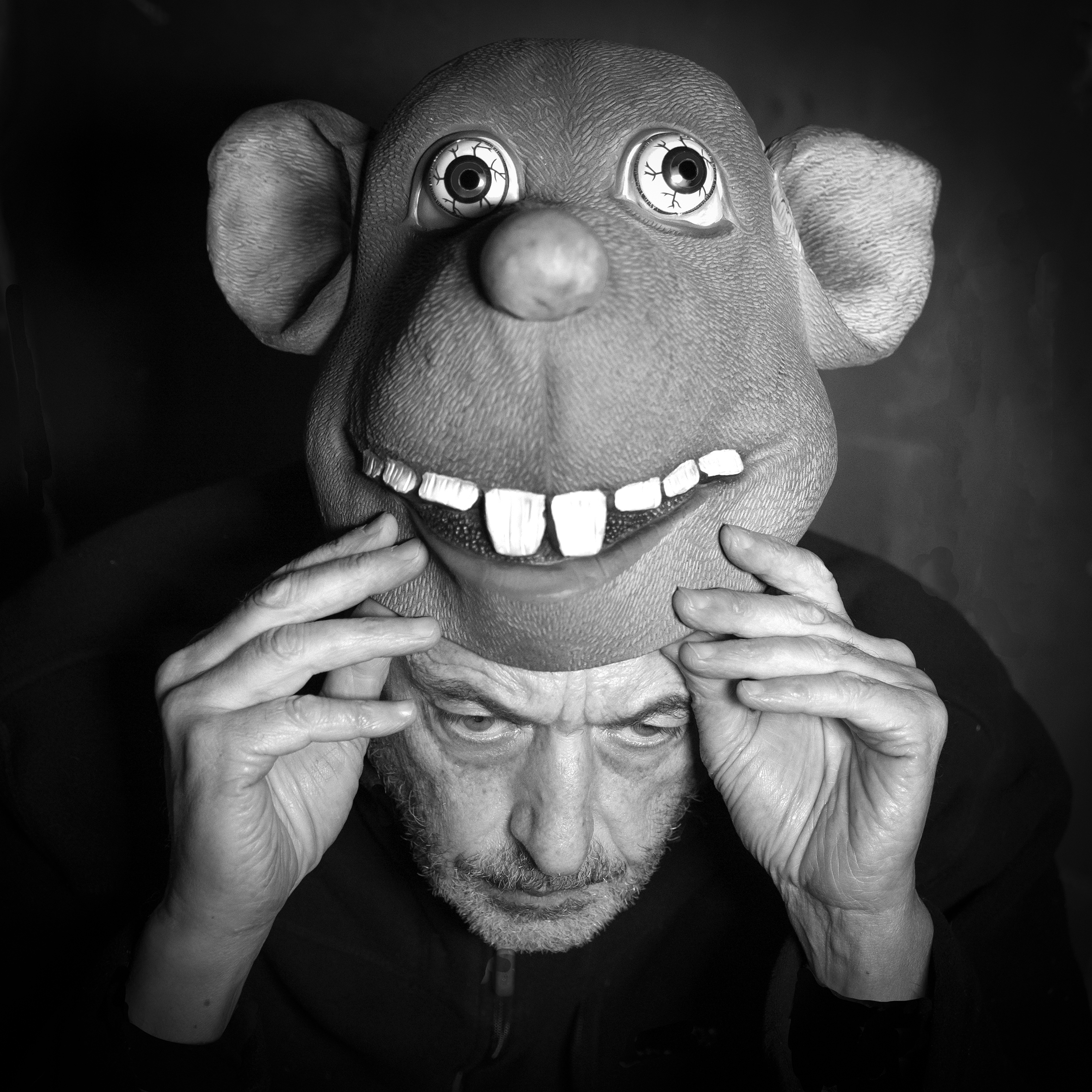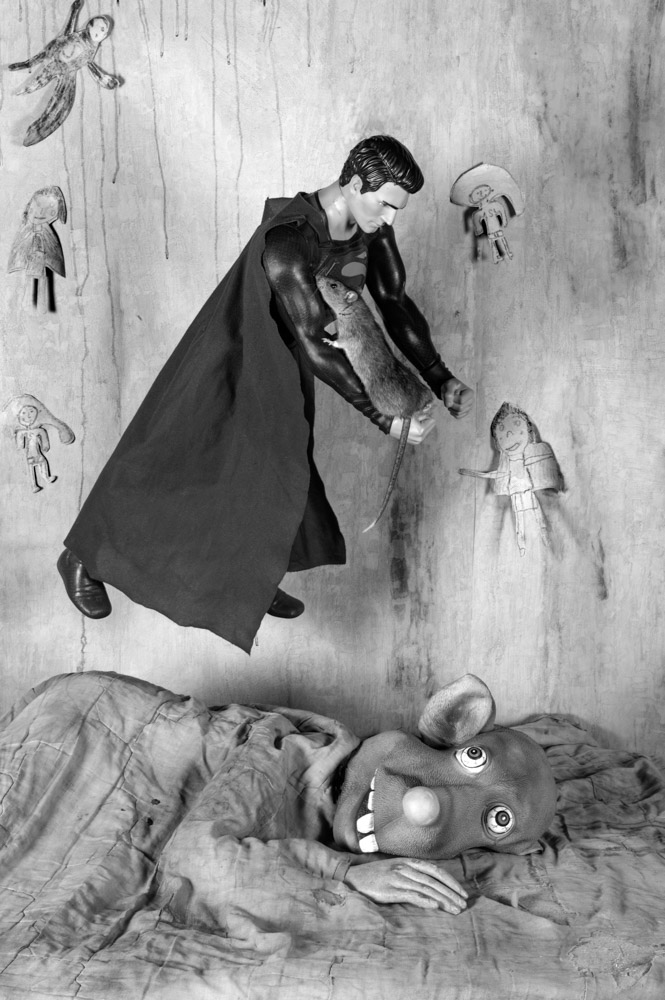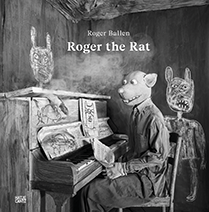I am an outsider, live on the margin and have no place in human society. I am judged by humanity to be insane, to be feared and avoided at all costs.
Thus reads an extract from Roger Ballen’s latest title, Roger the Rat.
A dissection of the human psyche in as much as it is a critique of societal expectations, Ballen’s work explores the subconscious – both his and ours – by means of an un-PC rat, the eponymous Roger.
Engaging in acts deemed ‘devious’, living in a hovel of a Hades, and treating women and children with equal disregard, the stark black-and-white photos of Roger’s world evoke a sense of discomfort as this rodent abandons morality in favour of living a life unconstrained by societal norms.
Ballen’s distinctive style – which has come to be known as ‘Ballenesque’ – is tangible as he introduces the reader to Roger’s lifestyle and surrounds. Think bare walls. Filthy bedding. Dead-eyed mannequins. Chains. Live birds. Chalk drawings. And rats. Many, many rats.
 Prank, 2020
Prank, 2020
“Dark” is the “normal word” people adopt in response to Ballen’s work, he says during our interview at his recently constructed art centre on Johannesburg’s Jan Smuts Avenue.
Yet Ballen maintains that he doesn’t differentiate between “dark” and “light” as standing in contrast to another as either “bad” or good”.
“It’s a very revealing word,” the native New Yorker continues in his deep and melodic voice.
“It immediately shows a state of psychological repression. The pictures are making them anxious, they’re getting into a side of themselves that they can’t deal with. That makes them nervous or scared, ’cause it makes them come to terms with their own state of being. That says something about the person.”
It soon becomes apparent that a conversation with Roger Ballen goes in a number of different directions.
Compiled between 2015 and 2020, the images in Roger the Rat are dated, yet achronologically so, with the final image ‘The End’ taken in 2015. Ballen explains that it’s a picture book, not a documentary book: “The pictures don’t have any real relationship to any particular period of time”. But there is an order to them.
What’s in a name?
Ballen seems capable of answering a question before I ask it, as the topic of subheadings arises.
“The way I did this book, from the point of view of setting up the book, was to write subheadings,” he acknowledges.
“Subheadings [of Roger] being funny to women, subheadings where he’s being violent, there’s a subheading of him being nice to people, there’s a subheading with other rats. I decided in this case, in this project, to make it narrative subheadings.”
The first image adjacent to the title page features Ballen donning Roger’s mask, sans caption or date. He says that the photo was taken in 2020 by his artistic director, Marguerite Rossouw, to whom he dedicates the book.
It made sense to include that specific picture, Ballen states, because the book is called Roger the Rat.
 Roger the Rat, taken by Marguerite Rossouw
Roger the Rat, taken by Marguerite Rossouw
“There is the rat-head, then there is me. I wasn’t in any of the pictures. There were a few people. Some are just mannequins, some are young boys. When you start a project like this you don’t know what you’re doing. You just take the pictures.”
‘Sex’ was one of the narrative subheadings Ballen employed as he delves into Roger’s mind, with ‘Arousal’ depicting Roger with a rather sizable erection…
“He does!” Ballen grins, quipping that “he keeps it up, he’s a young guy, he doesn’t have to take any pills”.
 Arousal, 2015
Arousal, 2015
“He’s not a nice guy”
In ‘Pinned Down’ one of the female mannequins in Roger’s subterranean hideaway is positioned as mounting a stuffed tiger, which suggests an image verging on bestiality.
“Oh, yes,” Ballen nods, “I told you Roger doesn’t think like that. He finds those things quite interesting. He’s not a politically correct being. He’s enjoying things that other people would feel embarrassed about.
“That’s Roger,” he says. “Roger doesn’t care. He lives underground somewhere; some sort of subway station or something. He doesn’t care about what’s going on up there. He’s not part of it, he’s not related to it.”
The subconscious panopticon modern humankind has subjected itself to is considered in Ballen’s photography by means of Roger’s deviation from societal norms and expectations.
“What is Roger the Rat?” Ballen asks. “Roger the Rat is a human id, he does things that you’re not supposed to do. He does things that a lot of people would like to do, he acts out his subconscious emotions. That’s what he is. Sometimes when you do that – here you might be seen as absurd or insane or it might be seen as unsociable, it might even be seen as criminal – but this brings up all sorts of issues to try to define what these terms really mean in a so-called normal society.
“Roger is a reflection of that human instinctual type of behaviour that people can’t act on, and might act out in their own minds, but not reveal what they’re really thinking or feeling. You can see Roger as humorous, you can see Roger as insane, you can see Roger as violent. In the movie he’s very violent. He’s not a nice guy. He really isn’t,” Ballen continues, brow furrowed, earnest eyes.
Roger the Rat: a creation of Roger the Mind
In the prologue Ballen has Roger specify that I’m unsure whether I’m a rat or a human. To what extent does Roger, the human, relate to that statement?
“Meaning myself?” Ballen asks.
Yes.
Ballen’s reply draws on the similarities rats share with modern humankind.
“If you think of evolutionary biology, if you believe in it – there’s maybe nothing else to believe in,” he adds with a hint of a smile, “the planet started out with a single cell, it became more differentiated. In a way we come from similar roots. We all have a little bit of that, little bit of this.
“If you look at a rat, I mean, other than the size of the brain,” he muses, “really everything in a rat’s body is what you have – a kidney, lungs, brain cells. Everything in that rat functionally that’s in a human being, or a dog, or giraffe. There is some sort of singular continuity in some way.”
Ballen’s recognition of and respect for rats – rodents, he forthrightly states, deemed dirty and disease-carrying in westernised societies – is evident, as he emphasises their survival ability, the essential role they place in ecology, and the complexity of their brains.
The rat as symbol of disorder and representative of filth, death, and disease becomes a psychological threat to humans, says Ballen. “They’re dirty, they carry disease, so then they threaten people’s psychological beings. Where they live and what they eat make people uncomfortable.
“Mice and rats are crucial to the ecology, they play a huge role for species maintenance all over the world. If you eliminate rodents in the world, you eliminate wildlife,” he soberly acknowledges.
The artist’s stream-of-consciousness thought process is evident as our conversation progresses, with Ballen continuing that Roger the Rat is a creation of Roger the Mind.
“There’s no point in calling him something else, he’s a part of my imagination. There’s no better word than ‘Roger’ for the rat. He’s like an alter ego. He could be an alter ego of my mind but Roger the Rat slips into your mind and then he’s an alter ego of your mind,” Ballen stresses. “And if it’s a good work of art then it will stay with you, or with anybody else. Roger the Rat is an archetypal character.”
This ties in with Ballen’s art as redolent of a subconscious space: in the prologue, Ballen – as Roger the Rat – writes that Roger’s underworld is “a place of my rat mind, my human mind, and your mind”.
Why include this specific statement?
Ballen pauses.
“If something has an effect on people as an artwork, then the artist’s world has to encroach on your world, and have a transforming effect in some way or another.”
It is Ballen’s hope that what you see here is a part of that, adding that if you identify with this rat – or even try to reject him – you’re projecting some sort of emotion towards him: “you’re already in his world”.
He goes on by saying that his work has always had a psychological edge to it. That his pictures aren’t planned. That he doesn’t intentionally set out to disturb somebody, or make somebody laugh.
“Hopefully it has an organic content to it that has an ability to impact somebody’s state of being. That’ll be my goal. I can’t measure anybody, it’s non-measurable. What somebody said might be different than what they feel, and what they feel they can’t put into words.
“I do know, from all the years I’ve been doing this, that my pictures have an effect on people. Somehow, I don’t know in what way. They don’t forget them.”
Ballen as dream artist
 Rat Dream, 2018
Rat Dream, 2018
Ballen’s fascination with the subconscious manifests via Roger’s nocturnal activities, which include dreaming and drawing his dreams, as Ballen writes:
For some time, except for the rats, I had to live alone in my house. On my nighttime excursions I would often notice graffiti on many of the building of the city that I lived underneath. I was drawn to the strange faces and bodies that decorated the walls. One night I dreamed that the walls of my house were covered with rat faces all talking to me at the same time, asking my permission to be fixed to the wall. Upon waking I started drawing the faces I saw in my dreams. Most of my drawings had rat/human faces drawn with chalk that I begged from young children. I gave each one of these drawings a name, sometimes the same name as some rats that were living with me.
Ballen explains that “the type of drawings that you see in my work come from a very subconscious source, like dreams come from a subconscious source.
“There’s a link between the type of drawings that might be seen in my photographs, that I drew. They’re very spontaneous types of drawings, they’re not sophisticated drawings, or documentary drawings, or abstract drawings. They come from the same element of dreamlike, subconscious expression. Drawings like this are a form of subconscious expression.”
Throughout the book, Roger increasingly adopts anthropomorphic characteristics: he’s attracted to mannequins who resemble women, he cooks, he smokes, he seeks companionship.
What he really does, Ballen explains, is to ultimately destroy. Although not overtly depicted in the photos, the accompanying video shows Roger collecting mannequins – mostly women, bringing them home, trying to make dinner for them, yet he physically destroys them.
“He creates life in this hovel of mannequins,” says Ballen. “He’s an outsider, he’s isolated from the world around him. He would be seen as alienated, marginalised, an outsider”. In short: if he were a human, he would be considered insane.
Ballen’s Asylum of the Birds, published in 2014, features images of people – literally and figurately – living on the periphery of society, deemed “insane” according to societal criterion, yet Ballen hasn’t photographed live human beings in their houses in the past three or four years.
Did he consider photographing humans again, or was it always going to be a rat?
Animals – dead or alive – and mannequins have become his preferred subject, and he’s aiming on continuing in that trajectory, expressing disdain towards people in the artworld who “find something that they’re successful with and just stick with it.
“You can make an upside-down Mickey Mouse and sell that for a million dollars; make an upside-down Donald Duck next time and sell that for a million dollars,” he proclaims with a slight hand gesture. “That’s never been my goal. I never did this commercially, it’s always been a passion. Unless there was a reason or passion for doing it, I wouldn’t want to do it again. It’s like trying to go back and try and play basketball again. I can’t.”
He still has the height, I say.
“Well, that’s about it.”
And the shoes.
“I can only get about this far with my feet,” Ballen says, imitating a stretch.
Instagram: it’s easy but not profound
Ballen’s disdain for the near-symbiotic nature of modern art and commercialisation is paralleled in his antipathy to Instagram, a social media platform which he employed as means to promote his book, yet harbours feeling of resentment for owing to the lack of value.
Prior to the publication of Roger the Rat, Ballen released six Instagram videos as previews for his 113,000 followers. His reasoning for reverting to the much-contested ‘Gram is threefold.
“First thing,” Ballen starts, “what’s happened is that printed medium is a dying thing, there’s a limit to what you can do. Second thing: there’s not that much in printed media that necessarily focuses on art photography. The third thing: I’m not living in New York or Paris, I’m living in the bottom of Africa here. So, how do you get the thing out?”

He adds that the world is “totally oversaturated with images, it’s beyond saturated”. (Here’s looking at Kim Kardashian and co and the lack of value systems attached to Instagram imagery, à la Ballen.)
His preference for the IRL (in real life) promotion versus URL (online) promotion is tangible, as he proclaims that “in an ideal world you’d like to promote something on a different level. It’s great that you’re doing this today”.
He’s talking about our face-to-face interview, which he prefers to a phone interview in which an interviewer “has no idea of anything about me, they saw a few pictures on Instagram, ask the same questions over and over again”.
Interviews like this, “where a person puts in time and energy in trying to understand the work, and unwrap it in their own way”, remains his favoured modus operandi.
Yet, Ballen says that face-to-face interviews are difficult when you have “one person sitting in the bottom of Africa in a world mid-virus, in a world that’s oversaturated, there’s no other way of doing this. People think it’s an end-all, they’re wrong”.
He concludes that although Instagram as means of promotion is “an easy way of doing things, it’s not necessarily a profound way of doing things”.
The unsolvable riddle
All six preview videos published on his Instagram account end with Ballen’s voice ominously and heavily questioning “Who. Am. I?”
Why this specific query?
“That’s a very good question to ask me, because if you actually turn the camera around, point it to yourself, and say ‘who am I?’ What are you going to say?” Ballen challenges. “I occasionally do that to classes: “take the camera and photograph ‘who am I?’
“Now what would you do? You wouldn’t know what to do.”
Put on a mask and not answer the question, I venture.
“But what mask are you going to put on?” Ballen asks. *cue silence and awkward laughter*
“It’s actually a totally profound question because nobody can answer the question,” Ballen continues. “We think we’re in control of everything, we think we have some idea of our identity, that we understand something of us.
“But when somebody asks the most basic question ‘who am I?’ you don’t even have one word to answer it with. You just say ‘I’m nothing’,” he shrugs.
(A fitting observation from someone renowned for stating that ‘nothing’ is the most profound word in the English language.)
“That’s the theatre of the absurd,” Ballen continues. “Roger is a reflection of the theatre of the absurd, what he’s doing has no meaning, it’s purposeless.
“Most people think they’re in control of the answer, as a defense mechanism, but have no capability of dealing with the answer, and have no concept of even wanting to answer the question, and are scared to even ponder the issue ’cause it is a very scary question,” he resolutely concludes.
Oh, and Ballen assured me that no rats were harmed in the making of this book.
Roger that.

Comments are closed.